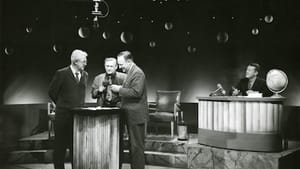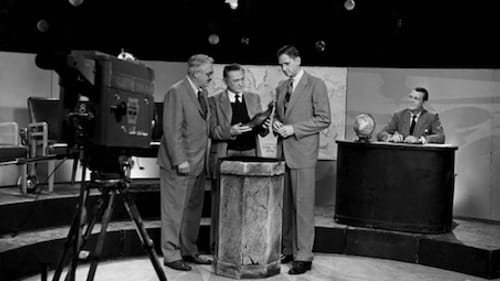Stay in the Loop
BSR publishes on a weekly schedule, with an email newsletter every Wednesday and Thursday morning. There’s no paywall, and subscribing is always free.
'What in the World' brought archaeology home
Penn Museum presents 'What in the World?'

Normally a portal to ancient worlds, Penn Museum unearths a more recent period: the dawn of television.
What in the World? (WITW), a program produced by the Penn Museum from 1950 to 1966, was originally broadcast live in black and white — almost Ptolemaic, by current media standards.
Professors solving puzzles on live television
WITW was the first U.S. network series on archaeology, at a time when fewer than one in ten American homes even had a television.
Part NOVA, part What’s My Line?, it was a brainy quiz show in which smart people solved puzzles. It had no prizes, no point totals, no overwrought drama, and certainly no instant fame. An object was presented to a panel for brief inspection and they hypothesized about its purpose, age, and origin. Panelists did not see the artifacts until they were on air. An offscreen announcer identified the items in advance for viewers.
Unsuspected talents
The three-member panel consisted of experts and knowledgeable amateurs, some of them famous. Anthropologist Margaret Mead sat in once, as did actor Vincent Price, in 1954, when he was performing in a play in Philadelphia. Price, a student of art history and a collector, held his own, correctly identifying a 19th-century crocodile carving from New Guinea’s Sepik River region.
Penn anthropologist Carleton Coon was a frequent and popular participant who belied the staid professorial stereotype. Coon, known for off-the-cuff repartee, humor, and language prohibited on live television, caused a mute button to be added to the set.
Program staff took pains to select items unfamiliar to in-house panelists and occasionally threw in red herrings, such as a modern Guatemalan sash. The sash appeared on the same episode as 5,000-year-old precious beads from southern Iraq and Peruvian pottery fired centuries before Columbus arrived in the Americas.
Television history
WITW’s run encapsulates the early history of its medium. It was first recorded on kinescope, a movie camera capturing the live image from a television monitor. Videotape accelerated production, enabling five episodes to be recorded in a single day and held for future broadcast.

The set was simple: three panelists’ chairs, a desk for the host, and a podium for the item under consideration. To create drama, each episode opened with mysterious smoke drifting across the television screen — a tub of dry ice simulating the mists of time.
Though at the time almost all television was broadcast in black and white, Froelich Rainey, Penn Museum director at the time and the show’s host, was anxious to broadcast in color, believing archaeological items looked best in color, explains Alessandro Pezzati, Penn Museum senior archivist. In 1957, WITW moved to color production, though few viewers could appreciate the difference. Color TV households were rare in 1957: the earliest available statistic, for 1964, indicates just 3 percent of homes had color television.
Exposure brings accolades
Despite loyal and vocal viewership and copies in other markets, WITW never acquired a regular sponsor. The series aired for a time, vanished, and then resumed. The pattern persisted throughout its 16-year run.
WITW’s creativity and popularity led to national syndication on CBS from 1951 to 1955. It aired on as many as 89 stations, including its home station, Philadelphia’s WCAU-TV. Later, WITW was also broadcast on National Educational Television, a forerunner of the Public Broadcasting System.
In 1951, WITW received the prestigious Peabody Award for excellence in television and radio programming. Other Peabody winners that year included Gian Carlo Menotti for Amahl and the Night Visitors, Edward R. Murrow for See It Now, and Alistair Cooke for BBC’s Letter from America.
Sincere flattery
Following a 1952 appearance on the show, British archaeologist Mortimer Wheeler created Animal, Vegetable, Mineral? for the BBC. Penn lent him objects inspected by Queen Elizabeth II and Prince Philip prior to broadcast.
For all their academic achievement, WITW experts were refreshingly average on air, a reminder that people weren’t always as camera-ready as they now seem. A 1952 issue of Life magazine credited the program’s appeal, in part, to their demeanor: “It offers lively entertainment, palatable morsels of archaeological lore, and a gentle reminder that scholars can be folksy and funny as well as formidable.”
Just eight original episodes survive, copies of which reside in the collection of the Paley Center for Media. Pezzati, who curated the exhibit with Kate Pourshariati, hopes to find more.
Unlike other Penn Museum artifacts — static, silent ambassadors for their times — WITW speaks for itself, offering a live glimpse into a media landscape that no longer exists: one that, as producer George Dessert once wrote, “dares to be popular without being condescending.”
What, When, Where
What in the World? Early Television Meets the World of Archaeology, 1950-1966. Ongoing. Penn Museum, 3260 South Street, Philadelphia. (215) 898-4000 or pennmuseum.org.
Sign up for our newsletter
All of the week's new articles, all in one place. Sign up for the free weekly BSR newsletters, and don't miss a conversation.
